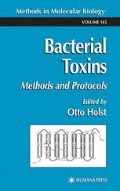Abstract
When a fluorophore absorbs a photon, an electron is excited to a higher energy level. This excited state electron returns to its ground state by one of two competing processes. In radiative de-excitation, a brief relaxation time (about 10-12 s) is followed by the electron’s return to the ground state accompanied by the emission of a photon whose wavelength is longer than the one absorbed (1). Fluorescence emission competes with nonradiative processes that also allow the electron to return to the ground state. Because the competition between these processes is influenced by the fluorophore’s surroundings, the nature of the emitted light provides information on the microenvironment of the probe. Therefore, when a fluorophore is part of a macromolecular structure (such as a protein or protein-containing complex), its fluorescence emission provides information on those events occurring within the structure.
Access this chapter
Tax calculation will be finalised at checkout
Purchases are for personal use only
References
Lakowicz J. R., ed. (1983) Principles of Fluorescence Spectroscopy, Plenum New York.
Calderwood S. B., Auclair F., Donohue-Rolfe A., Keusch G. T., and Mekalanos J. J. (1987) Nucleotide sequence of the shiga-like toxin genes of Escherichia coli. Proc. Natl. Acad. Sci. USA 84, 4364–4368.
Surewicz W. K., Surewicz K., Mantsch H. H., and Auclair F. (1989) Interaction of shigella toxin with globotriaosyl ceramide receptor-containing membranes: a fluorescence study. Biochem. Biophys. Res. Commun. 160, 126–132.
Spangler B. D. (1992) Structure and function of cholera toxin and the related E. coli heat-labile enterotoxin. M icrobiol. Rev. 56, 622–647.
Merritt E. A., Sarfaty S., van der Akker R., L’Hoir C., Martial J. A., and Hol W. G. J. (1994) Crystal structure of cholera toxin B-pentamer bound to receptor GM1 pentasaccharide. Prot. Sci. 3, 166–175.
DeWolf M. J. S., Fridkin M., Epstein M. M., and Kohn L. D. (1981) Structure-function studies of cholera toxin and its A protomers and B protomers. J. Biol. Chem. 256, 5481–5488.
DeWolf M. S. J., Van Dessel G. A. F., Lagrou A. R., Hilderson H. J. J., and Dierick W. S. H. (1987) pH-induced transitions in cholera toxin conformation. Biochemistry 26, 3799–3806.
Picking W. L., Moon H., Wu H., and Picking W. D. (1995) Fluorescence analysis of the interaction between ganglioside GM1-containing phospholipid vesicles and the B subunit of cholera toxin. Biochim. Biophys. Acta 1247, 65–73.
McCann J. A., Mertz J. A., Czworkowski J., and Picking W. D. (1997) Conformational changes in cholera toxin B subunit-ganglioside GM1 complexes are elicited by environmental pH and evoke changes in membrane structure. Biochemistry 36, 9169–9178.
Wu P. and Brand L. (1994) Resonance energy transfer: methods and applications. Anal. Biochem. 218, 1–13.
dos Remedios C. A. and Moens P. D. (1995) Fluorescence resonance energy transfer spectroscopy is a reliable “ruler’ for measuring structural changes in proteins: dispelling the problem of the unknown orientation factor. J. Struct. Biol. 115, 175–185.
Haas E., Katzir E.-K., and Steinberg I. Z. (1978) Effect of orientation of donor and acceptor on the probability of energy transfer involving electronic transitions of mixed polarization. Biochemistry 17, 5064–5070.
Dale R. E., Eisinger J., and Blumberg W. E. (1979) The orientational freedom of molecular probes: the orientation factor in intramolecular energy transfer. Biophys. J. 26, 161–194.
Sonnino S., Acquotti D., Riboni L., Giuliani A., Kirschner G., and Tettamanti G. (1986) New chemical trends in ganglioside research. Chem. Phys. Lipids 42, 3–26.
Laemmli U. K. (1970) Cleavage of structural proteins during the assembly of the head of bacteriophage T4. Nature 227, 680–685.
Stern D. and Volmer M. (1919) On the quenching-time of fluorescence. Phys. Zeitschr. 20, 183-188.
Csortos C., Matko J., Erdodi F., and Gergely P. (1990) Interaction of the catalytic subunits of protein phosphatase-1 and 2A with inhibitor-1 and 2: a fluorescent study with sulfhydryl-specific pyrene maleimide. Biochem. Biophys. Res. Commun. 169, 559–564.
Flitsch S. L. and Khorana H. G. (1989) Structural studies on transmembrane proteins. 1. Model study using bacteriorhodopsin mutants containing single cysteine residues. Biochemistry 28, 7800–7805.
Picking W. D., Kudlicki W., Kramer G., Hardesty B., Vandenheede J. R., Merlevede W., Park I., and DePaoli-Roach A. (1991) Fluorescence studies on the interaction of inhibitor-2 and okadaic acid with the catalytic subunit of type 1 phosphoprotein phosphatase. Biochemistry 30, 10,280–10,287.
Highsmith S. and Murphy A. J. (1984) Nd3*+ and Co2*+ binding to sarcoplasmic reticulum CaATPase: an estimation of the distance from the ATP binding site to the high-affinity calcium binding sites. J. Biol. Chem. 259, 14,651–14,656.
Zhang R.-G., Westbrook M. L., Westbrook E. M., Scott D. L., Otwinowski Z., Maulik P. R., Reed R. A., and Shipley G. G. (1995) The 2.4к crystal structure of cholera toxin B subunit pentamer: choleragenoid. J. M ol. Biol. 251, 550–562.
Dawson W. R. and Windsor M. W. (1968) Fluorescence yields of aromatic compounds. J. Phys. Chem. 72, 3251–3260.
Author information
Authors and Affiliations
Editor information
Editors and Affiliations
Rights and permissions
Copyright information
© 2000 Humana Press Inc.
About this protocol
Cite this protocol
Picking, W.D. (2000). The Use of Fluorescence Resonance Energy Transfer to Detect Conformational Changes in Protein Toxins. In: Holst, O. (eds) Bacterial Toxins: Methods and Protocols. Methods in Molecular Biology™, vol 145. Humana Press. https://doi.org/10.1385/1-59259-052-7:133
Download citation
DOI: https://doi.org/10.1385/1-59259-052-7:133
Publisher Name: Humana Press
Print ISBN: 978-0-89603-604-8
Online ISBN: 978-1-59259-052-0
eBook Packages: Springer Protocols

